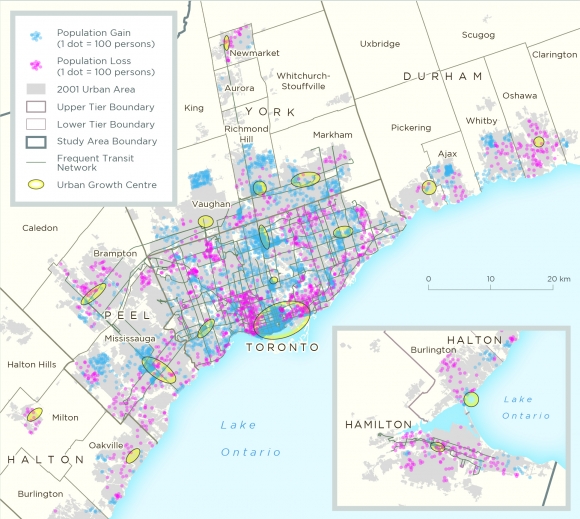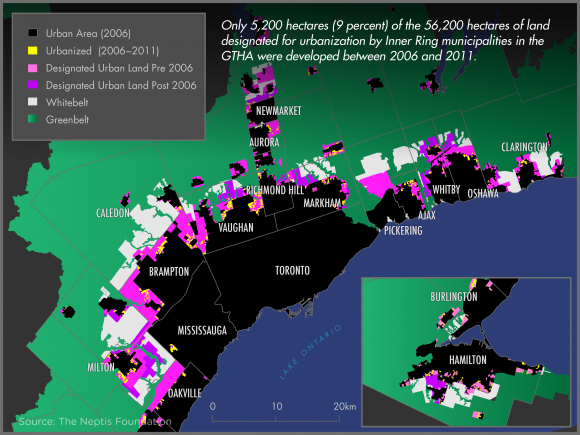Latest
A Neptis Foundation report Planning for Prosperity which documents the current and evolving economic geography of the Toronto region was the subject of a recent panel discussion on TVO's flagship show The Agenda. On hand to discuss the report with host Steve Paikin was author Pamela Blais, Marcy Burchfield, executive director of the Neptis Foundation and Jan De Silva, President and CEO of the Toronto Region Board of Trade.

The Neptis Foundation is pleased to release a new report by Pamela Blais on the Growth Plan for the Greater Golden Horseshoe and the transforming regional economic geography of the region.

This report maps and analyzes the dynamics of long-term structural changes - not merely cyclical market fluctuations - brought about by globalization and rapidly evolving technology in the economy of the Greater Golden Horseshoe. The report concludes that the Growth Plan for the GGH is not grounded in the reality of the region's economic geography.

On November 12, 2015, Marcy Burchfield appeared on The Agenda with host Steve Paikin as part of a panel that also included Keith Currie of the Ontario Federation of Agriculture and Joe Vaccaro of the Ontario Home Builders' Association.

This report maps and analyzes the dynamics of long-term structural changes - not merely cyclical market fluctuations - brought about by globalization and rapidly evolving technology in the GGH economy. The study reveals a regional economic landscape characterized by concentrations of employment in Downtown Toronto, three large suburban employment megazones, and five Suburban Knowledge-Intensive Districts (SKIDs). Like Downtown Toronto, these megazones and SKIDs, contain a high proportion of "core" jobs, that is, jobs in the "tradeable" sectors that draw income into the region and are key to innovation and competition.
The author notes that the megazones and SKIDs are not recognized in The Growth Plan for the Greater Golden Horseshoe or in The Big Move, which focus instead on potential growth nodes called Urban Growth Centres (UGCs). The report contains suggestions for ways in which planning in the GGH could be better oriented towards ensuring a competitive, prosperous region that attracts businesses and investment.

In August 2014, newspaper headlines trumpeted the "Manhattanization" of Toronto. City Council, in the span of two days, approved 18 new high-rise apartment and office buildings in downtown Toronto, on top of 70,000 residential units already approved for construction. But what happens in downtown Toronto is only a small part of a much larger story of growth across the Greater Toronto and Hamilton Area (GTHA).

This report compares the growth patterns of the Greater Toronto and Hamilton Area (GTHA) between 2001 and 2011 with that of Metro Vancouver. Both city-regions have growth management plans in place - the Growth Plan for the Greater Golden Horseshoe in Ontario and a regional growth strategy called Metro Vancouver 2040: Shaping Our Future in British Columbia. Although the Toronto region has reduced its rate of land consumption since the 1990s, 86% of the population increase between 2001 and 2011 was housed in new subdivisions built on greenfield sites, while in Metro Vancouver, 70% of the population increase went to intensification areas.
In both cities, the number of new dwellings outpaced population growth, most likely because of the Canada-wide trend towards smaller households. As intensification has not kept pace with growth in the GTHA, many established urban areas lost population between 2001 and 2011, whereas population loss was rare in Metro Vancouver. Metro Vancouver also offers a broader range of housing options than the GTHA, where new housing mainly takes the form either of single detached houses or of condominium apartments. The report concludes that Metro Vancouver's growth strategy is more effective than Ontario's Growth Plan in directing growth to areas that are already well served by transit and other infrastructure.
The paper explains key features of the Plan, highlights questions surrounding its implementation, and presents Neptis research on the rate of urbanization over 20 years in fast-growing urban regions across Canada. The research shows that although the rate of urban expansion - i.e., land consumption at the edge - has slowed down in recent years even before the establishment of the Growth Plan, much greater effort can be made, in the GTHA in particular, to create a more diversified and affordable housing stock in newly developed suburban areas.

Under the Growth Plan for the Greater Golden Horseshoe, municipalities in the Greater Toronto and Hamilton Area set aside 56,200 hectares for development to 2031. Between 2006 and 2011, only 9% of this area was actually developed. This finding suggests that the current land supply for the region may last well beyond 2031.

The Toronto Star recently published an article about the Growth Plan review in which Marcy Burchfield and Philipa Campsie of the Neptis Foundaiton are are quoted about research that can inform the Provincial review of various land use plans.

Executive Director Marcy Burchfield was invited to speak at the City Institute Seminar Series where she discussed the latest Neptis Brief Rethinking Suburban Sprawl: Is planning policy leading or following the market? Preliminary findings show that in the past 20 years, while the populations of the Vancouver, Edmonton, Calgary, and Toronto city-regions continue to expand, the rate at which new land is being urbanized at the edge has decreased over time - sometimes quite dramatically.


